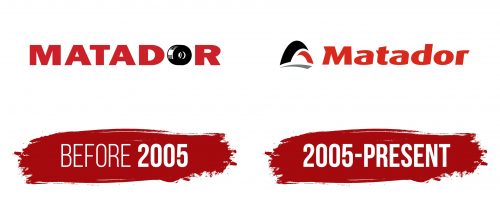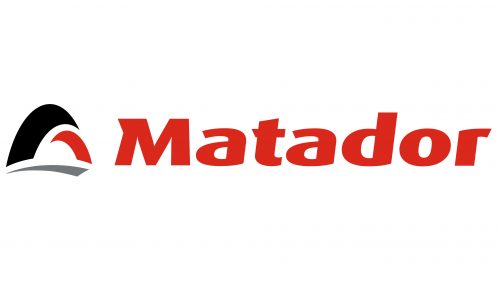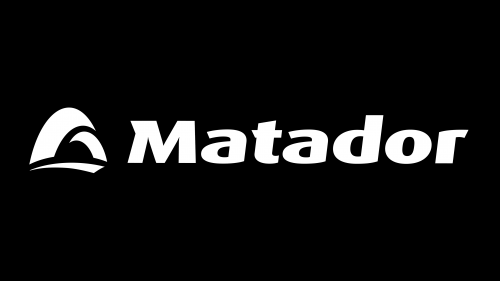The Matador logo reflects the strong force and resilience with which the manufacturer’s tires overcome challenging road conditions. The emblem’s visual elements evoke a sense of rapid motion, suggesting fast-spinning car wheels.
Matador: Brand overview
On September 7, 1905, in the then-Austrian-Hungarian-dominated Slovakian town of Púchov, the history of Matador began. Entrepreneur Simon Zimmermann started the business by establishing a small workshop that produced textile and rubber goods.
Initially known as “Matador,” the company’s main products were rubber balls and basic rubber goods. Zimmermann selected the name “Matador” due to its resonance and connotations of grit and perseverance.
By 1912, the business added specialized rubber goods and rubber hoses to its line of goods. With this growth, the firm was able to solidify its position in the neighborhood market and begin exporting its goods to other parts of the Austro-Hungarian Empire.
The company faced difficulties during World War I (1914–1918) but responded by rerouting some of its output to fulfill military requirements.
The enterprise kept evolving following the war and the creation of Czechoslovakia in 1918. When the company began producing car tires in 1925, it took a big step forward. The decision was made due to the region’s developing automotive industry and rising demand.
The 1930s were a time of tremendous expansion for the business. The firm started exporting its goods to other European nations as it increased its production capability. To broaden its product line further, it began producing bicycle tires at this time.
Once more, the company faced significant obstacles during World War II (1939–1945). A portion of the production was diverted to suit military requirements, and several plants sustained damage from the fighting.
Following the end of the war, the new communist government of Czechoslovakia nationalized the enterprise in 1946. Even when the ownership changed, the business developed and increased production.
The firm started investing in R&D in the 1950s, developing new tire varieties and higher-quality products. Around this time, the business also began manufacturing tires for tractors and other agricultural equipment.
The production industry saw significant expansion and modernization in the 1960s and 1970s. With the introduction of radial tires, the company greatly enhanced the performance of its goods. During this time, the corporation began exporting to Western Europe and the Middle East, increasing its global reach.
The company kept funding the development of new technologies and increased output during the 1980s. The firm expanded into new market areas when it started manufacturing tires for trucks and buses.
The company’s history underwent a sea change in 1989. Following the communist regime’s overthrow and the “Velvet Revolution” in Czechoslovakia, the enterprise initiated privatization.
In the 1990s, the company underwent a difficult change and market economy adaptation. The corporation updated production, reorganized operations, and sought new foreign partners.
The business and the German company Continental AG established a joint venture in 1998 so that the firm could access new technologies and increase its market share abroad.
The 2000s were characterized by increased product range expansion and production modernization. The company started manufacturing tires for high-performance cars and kept bolstering its market share in Europe.
A new era in the enterprise’s history began when Continental AG purchased a majority position in the company in 2007. The firm joined Continental’s extensive worldwide network through this acquisition and obtained access to new markets and technological advancements.
With its historic history and brand intact, the enterprise has been a part of the Continental group since 2007. The company is still a major European automobile component market player, producing tires and other rubber goods.
In 2008, the firm continued its expansion and manufacturing upgrading plan. At its main facility in Púchov, Slovakia, the company upgraded its equipment with major financial investments. These expenditures, intended to increase production efficiency and product quality, solidified the enterprise’s position in the European tire industry.
To commemorate its 105th anniversary, the company introduced a new range of high-performance tires for passenger cars in 2010. This range, created using cutting-edge technologies, was aimed at the luxury car market and demonstrated the company’s dedication to tire industry innovation.
The enterprise launched a new line of truck and bus tires in 2012, further increasing its market share in the commercial tire industry. The commercial transportation segment’s increasing expectations for durability and fuel efficiency led to the development of this series.
The company established a new research and development center in Púchov in 2014, bolstering its capabilities. This center’s cutting-edge testing and development facilities for new tire designs and rubber compounds allowed the corporation to create novel goods quickly.
By launching a new range of tires designed for severe winter weather, the firm aggressively increased its market share in the winter tire industry in 2016. This line, created especially for Northern and Eastern European nations, scored highly in unbiased testing.
The business started a major initiative to digitize its production in 2018. This effort improved production flexibility and efficiency by implementing automation technology and intelligently managing production processes.
In response to the increasing demand in this automotive industry sector, the company launched its first range of tires specifically designed for electric vehicles in 2020. These tires’ low rolling resistance and low noise levels were specifically engineered to meet the needs of electric vehicles.
The firm unveiled a bold strategy in 2022 to become carbon neutral by 2040. To lower emissions throughout the tire production process, the company started investing in renewable energy sources and technologies as part of this goal.
The enterprise persisted in developing into a cutting-edge tire producer by adjusting to the shifting demands of the automotive sector and environmental issues.
Meaning and History
What is Matador?
It is a brand known for its products in two main sectors: tires and adventure gear. As a tire brand based in Slovakia, the company produces many tires for cars, trucks, and industrial vehicles. The brand is part of Continental AG, the world’s leading tire manufacturer, which ensures advanced product technology. In addition, the company designs and manufactures packable adventure gear, including backpacks and travel accessories aimed at travelers and outdoor enthusiasts.
Before 2005
The history of Matador began in 1905, but this logo appeared much later. It looks stylish and modern, thanks to its bold font, bright colors, and distinctive elements that reflect the company’s field of expertise. The designers placed the brand’s name at the center of its visual identity—a short word that, in the cultural context of Spain, refers to the main participant in a bullfight.
In a bullfight, the matador must be decisive, brave, confident, and able to maintain control, even in extremely dangerous situations. These are the qualities the tire manufacturer seeks to associate with, as its products need to withstand heavy loads and be durable, safe, and long-lasting. The Slovak company’s tires provide high speed and maneuverability for vehicles. Quick reflexes are also crucial in bullfighting, adding another layer of meaning to the brand name.
The word “MATADOR” is written in bold, uppercase letters. The font is geometric, straightforward, and sans-serif, without decorative details, giving it a modern and slightly futuristic look. The lettering appears visually powerful, as the uppercase style gives it a sense of weight and importance. Each glyph features smooth, clear lines and sharp angles, making the wordmark look stable. This font style highlights the company’s professionalism and the high reliability of its products.
Special attention is drawn to the letter “O,” replaced by a large tire. The designers made it black, using thin white lines to indicate the grooves and channels of the tread. The imitation of real tire texture gives the emblem a technical character, while the light, semicircular arcs inside the stylized “O” create a sense of depth, even though the style is far from realistic.
The tire is a powerful symbol of movement, progress, and innovation. For Matador, it represents the company’s products, which include tires for vans, SUVs, and passenger cars. This makes the logo a complete marketing tool, as it introduces the brand name and indicates its area of expertise.
The bright red color of the text symbolizes strength and energy. It also evokes the image of the red cloth that a graceful matador waves in front of an enraged bull. Black is used for a visual accent, making the tire more noticeable. It creates balance, preventing the emblem from being overly expressive. The appealing contrast of red and black characterizes Matador as a strong, dynamic, stable, and durable brand.
2005 – today
In September 2005, 100 years since its founding, Matador marked its anniversary by changing its visual identity. The new logo was intended to physically represent the brand’s evolution from an unknown manufacturer of rubber hoses into a global leader in the tire industry.
The Matador name is now displayed in a powerful, bold font with no equivalents. Everything about it is unique—from the single serif atop the “M” to the smooth curves ending in sharp points. The lettering is slightly tilted forward, reflecting the idea of continuous motion and hinting at the company’s progress toward modern technology. The letterforms are sharp and angular, yet not without smoothness. The sharp cuts at the ends of the “a,” “t,” and “r” harmonize with the triangular serif on the “M,” creating a contrast with the soft round shapes of ovals and semi-ovals.
To the left of the text is a symbol that captures attention with its expressive boldness. It consists of three flexible black, red, and gray stripes. This geometric pattern aligns with the brand’s name, as it can be interpreted as an abstract depiction of a bullfight, with the sharp curves representing the matador’s cape. However, considering the company’s field of work, the emblem encodes a different message:
- The black element symbolizes strong, durable tires that withstand the toughest conditions.
- The red arc is filled with energy, giving the impression of active movement.
- The gray line is associated with asphalt, dirt roads, or other driving surfaces.
Overall, the abstract design resembles a wheel (or, more precisely, the upper half of one). The curved shape of the lines turns them into speed lines, creating the illusion of rapid rotation. This dynamic quality is associated with the speed vehicles equipped with Matador tires can achieve. The logo radiates confidence, embodying high standards and innovation in every element.







